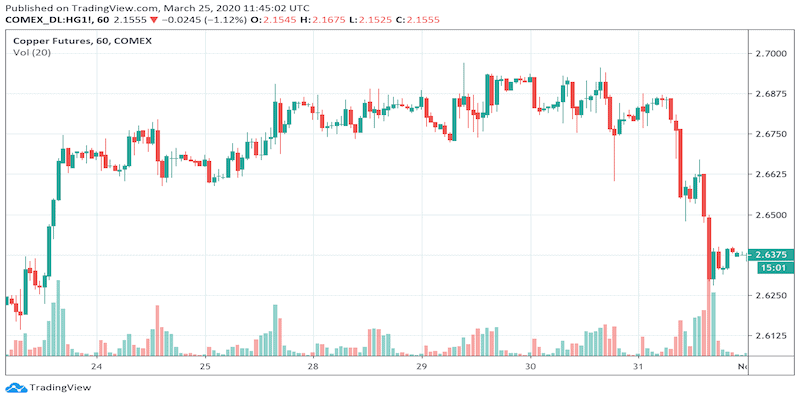Copper Trading | How to Trade Copper in 2025
Copper is an essential commodity to the world’s growth and to the development of our society. Copper is not only used in electrical equipment such as wiring and polls but also in construction, plumbing, industrial machinery, and motors. It is estimated that the discovery of copper dates from around 9000 BC, and therefore, you won’t be the first one to trade copper.
With the high number of uses of copper and the fact that copper is being used as an indicator for global economic growth, you might want to take advantage of this unique precious metal. It’s not covered widely in the media like gold and crude oil, however, it is highly affected by demand and supply and smaller markets such as copper, in comparison to gold/oil, often tend to provide endless trading opportunities.
In this guide, we will explore the copper markets. We will choose the top CFD brokers that offer copper trading and share some essential trading strategies to help you get started.
-
-
How to Trade Copper in 3 Quick Steps:
A trader should first identify the best method for trading copper. Spot copper can be purchased in the ‘open-market’ where individuals and producers can acquire copper from miners and retailers, but copper can also be purchased directly from exchanges that maintain the storage and the delivery of the commodity. Another effective way to trading copper is through the Contract for Difference (CFD) market, which allows traders to speculate on a commodity price without owning the asset.
We have outlined a step-by-step guide to help you get started:
Step 1: Open a Copper Trading Account
As previously mentioned, there are several ways to trade copper. A trader can start trading copper through the futures market, though it requires a long procedure before you can place your first order. Trading on futures exchange is entirely legitimate but you must be familiar with all terms and conditions and deposit a substantial amount of money. For example, if you decide to trade through the futures market you must acknowledge the fact that you have to close all positions before the delivery date or you will have to travel and pick up the commodity at the specified port.
For that reason, it is recommended to trade through the CFD market. The fees and commissions are low compared to the futures market and you won’t have to deposit a large amount of money. In fact, CFD brokers provide leverage and margin so you can get the most out of your trading account. Having said that, you must remember that leverage works the same way in reverse, it increases the profit potential but also the risk of losing your money. Therefore, you will have to find the right leverage ratio in which you can control your account balance.
Here are some of the most well-known broker that offer copper trading:
Plus500 - Competitive Spreads for Copper Trading
Plus500 has been in the industry for more than a decade since 2008. The company provides CFD trading in several markets including stocks, currency pairs, indices, cryptocurrencies, ETFs, and commodities. The broker offers a High-Grade Copper CFD contract with a 2 pips spread and a leverage ratio of up to 1:20.
Plus500 operates in more than 50 countries worldwide as the broker is regulated by the Australian Securities and Investments Commission (ASIC) in Australia, the Financial Conduct Authority (FCA) in the United Kingdom, and the Cyprus Securities and Exchange Commission (CySEC) in Europe.
Our Rating
- Offers a leverage ratio of up to 1:20 in line with regulatory compliance requirements
- Plus500 is regulated and a publicly-traded company on the London Stock Exchange (LSE)
- Plus500 offers a wide selection of stocks
- Plus500 charges overnight interest rate
- Does not offer the popular MetaTrader4
- Does not offer any learning resources
CFDs are complex financial instruments and 80.5% of retail investor accounts lose money when trading CFDs. Sponsored adStep 2: Learn How the Copper Market Works
What is Copper?
Copper is one of the most used metals in our daily life due to its physical properties which make it a vital commodity in many industries and fields. Unlike gold and silver, copper is available in abundant quantities and is highly subjected to supply and demand activities. It is believed that Copper is the first metal of mankind and has been in use since 9000 BC. Yet, its usage has grown with the rise of electricity and technology. Nowadays, copper has a special role as a leading indicator of global economic health and is also known as the “doctor” of financial markets. As the demand for copper rises, the sentiment for global growth is expected to be positive.
How the Copper Market Works
Trading copper is available through a range of platforms such as the physical bullion market, futures exchanges, CFDs, and ETFs. Three of the most popular copper futures contract include:
Comex High-Grade Copper – These copper futures contracts are traded on the Chicago Mercantile Exchange (CME). The CME is a major center for copper futures trading.
LME Copper – The London Metal Exchange (LME) is a commodity exchange that specializes in precious metals including copper. The LME serves as a global market for copper trading.
MCX Copper – The Multi Commodity Exchange reflects the spot and futures market for copper in India and Asia.
It’s advisable that you follow the three benchmark markets for copper. This will help you get a better indication of global and regional market sentiment. The price of copper is affected by supply and demand, meaning you have to be attentive to any rise in demand or supply disruptions:
US and China Demand
The US and China are the world’s two largest consumers of copper. So, watching these two countries’ domestic economies can provide a significant amount of insight into what copper will be worth in the future.
In the US, copper is used primarily for housing and construction projects. In fact, nearly half of the US copper demand comes from homebuilding. The price of copper increases as housing demand and new construction increase, and decreases as home values and new construction falls. Traders should be watching non-farm payrolls, mortgage rates, and housing indices in the US when evaluating copper prices.
In China, copper is used more for manufacturing than for construction. Growth in Chinese demand for copper as a raw material has played a major role in driving up the price of copper in recent years. Forecasts for Chinese manufacturing and exports have an important effect on copper prices.
Emerging Market Demand
While the US and China are the two biggest players in the copper trade, copper is used globally. As the population and wealth of developing nations increases, the world expects to see a concurrent rise in demand for copper. Traders should be evaluating the health of the global economy, not just the economies of the US and China when deciding whether the price of copper is likely to rise or fall.
However, emerging markets also affect the supply side of the price equation. As demand for copper has increased, more and more mines have opened in developing nations around the world to meet the supply. Furthermore, as the price of copper rises, it becomes economically feasible to mine copper in areas that haven’t seen mining previously. That increase in supply can act to keep the price of copper down even as global demand increases.
Supply Disruptions
Disruptions in supply can lead to dramatic swings in the price of copper on a short-term basis. For example, miner strikes in major copper-producing companies like Chile and Peru could cause a short-term drop in the supply of copper, which pushes up the price. Uncertainty around the nationalization of copper in Bolivia has also caused volatility in the price of copper. Copper traders need to be attuned to the risk posed by political and social unrest around the world as it relates to copper supply.
Substitutions
Copper isn’t the only metal that can be used in a lot of applications. If it gets expensive enough, homebuilders and manufacturers will turn to alternatives like aluminium and zinc. When trading copper, it’s important to be cognizant of where the price of copper is in relation to these alternative metals and how that can affect future demand.
Step 3: Choose a Copper Trading Strategy
Copper is a different type of market than gold and oil. It is quite similar to natural gas where the markets are mostly in consolidation but also have days of extremely high volatility. While finding the factors that drive copper prices is essential, you will have to find a mix of several key strategies to get the most benefit of copper trading.
On the fundamental side, the demand for copper is often perceived by analysts as an indicator of global economic health, hence, you must follow leading macroeconomics data released on a weekly and monthly basis. On the technical side, the integration of trading a consolidated market and ‘ride on the trend’ strategies might be the right approach to trade this commodity. Here are some tips that can help you get started:
Copper Technical Indicators – Fibonacci Retracement, MA, MACD, ADX, and RSI
Commodity traders mostly use momentum indicators to identify a trend. Some of the most popular technical analysis indicators include Moving Average (MA), Moving Average Convergence/Divergence (MACD), Relative Strength Index (RSI), and Average Directional Movement Index (ADX).
Another recommended indicator is a Fibonacci retracement that uses horizontal lines to determine entry and exit levels based on support and resistant levels. The benefit of Fibonacci retracement levels is that it does not only help identify market trends but also helps you find trading opportunities inside a consolidated market.
Form a Risk/Reward Ratio
A risk/reward ratio is an important rule of thumb for day traders. Though it highly depends on your trading style, a risk/reward ratio of 1:2 or 1:3 can ensure good trading risk management.
Copper – Market Consolidation
A consolidating market is identified as a market that traded in range-bound, meaning sideways moving market. Market consolidation occurs at a time when supply and demand are roughly equal and the copper market is often in a state in consolidated mode.
In that type of market condition, a trader will look to sell copper at the high resistance level and buy at the bottom support level. Yet, whenever the price breaks through a resistance or support level and the consolidation status ends, a trader will look to buy or sell the trend.
Copper and Australian Dollar Correlation
Copper and the Australian dollar have around 70% correlation. The catalyst behind this strong correlation is the fact that Australia is the fifth exporter of commodities and China is the largest importer of commodities.
Another important factor that influences copper prices is the status of the Chinese economy. China is copper’s largest consumer in the world with almost 50% of the total produced copper is being used by China.
Step 4: Open a Copper Trade
The final step is to choose a copper broker of your choice, after conducting your due diligence.
After you have registered your account, trade execution should be straightforward.
Conclusion
Copper trading can be volatile and a bit unclear at first sight. Yet, every trader has a niche and a favorite market to trade. Copper is similar to gold or crude oil markets but it has a unique price movement that might match your trading style. The same as any other commodity, you will have to learn what factors drive the prices of copper, the best trading hours, the seasonality of copper, and the best technical analysis indicators. But before you start trading copper, it’s important that you choose a well-reputed broker and get familiar with all the trading terms and the broker’s trading platform.
Day trading requires a high degree of self-discipline and emotional control. Some of the most well-known proprietary trading firms allow new traders to manage a non-profitable trading account for at least six months before they start to generate consistent profits. This is the learning curve of a day trader.
FAQs
What is the best time to trade copper?
Copper is being traded on the Chicago Mercantile Exchange from 23:00 to 22:00 GMT time and between 01.00 to 19.00 GMT on London Metal Exchange.
What is the ticker for copper?
The ticker symbol for copper on CME Globex is HG. On LME, copper’s ticker symbol is CA.
What are the main factors that affect copper prices?
Copper prices are mainly affected by supply and demand. Some of the most notable factors that affect copper prices are global economic growth, the housing market, political instability, emerging markets’ growth, natural disasters, and supply uncertainty.
How much money do I need to start trading gold?
For those who prefer to trade through the futures market, there’s an initial requirement of at least $1000 in order to start trading. However, if you decide to trade copper via a CFD broker such as Plus500, an initial deposit of $200-$500 would be enough due to the leverage provided by the brokers.
See Our Full Range Of Trading Resources – Traders A-Z
Tom Chen
View all posts by Tom ChenTom is an experienced financial analyst and a former derivatives day trader specialising in futures, commodities, forex and cryptocurrency. He has a B.A. in Economics and Management and his work has been published on a range of publications, including Yahoo Finance, FXEmpire and NASDAQ.com.
WARNING: The content on this site should not be considered investment advice. Investing is speculative. When investing your capital is at risk. This site is not intended for use in jurisdictions in which the trading or investments described are prohibited and should only be used by such persons and in such ways as are legally permitted. Your investment may not qualify for investor protection in your country or state of residence, so please conduct your own due diligence. Contracts for Difference (“CFDs”) are leveraged products and carry a significant risk of loss to your capital. Please ensure you fully understand the risks and seek independent advice. This website is free for you to use but we may receive commission from the companies we feature on this site.
Copyright © 2025 | Learnbonds.com
We use cookies to ensure that we give you the best experience on our website. If you continue to use this site we will assume that you are happy with it.Scroll Up




